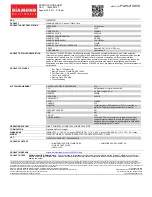
Glossary
©
National Instruments Corporation
G-9
P
PCI
Peripheral Component Interconnect. A high-performance expansion bus
architecture originally developed by Intel to replace ISA and EISA. PCI
offers a theoretical maximum transfer rate of 132 Mbytes/s.
PCLK
Pixel clock signal. Times the sampling of pixels on a video line.
picture aspect ratio
The ratio of the active pixel region to the active line region; for standard
video signals like RS-170 or CCIR, the full-size picture aspect ratio
normally is 4/3 (1.33).
pixel
Picture element. The smallest division that makes up the video scan line;
for display on a computer monitor, a pixel’s optimum dimension is square
(aspect ratio of 1:1, or the width equal to the height).
pixel aspect ratio
The ratio between the physical horizontal size and the vertical size of the
region covered by the pixel; an acquired pixel should optimally be square,
thus the optimal value is 1.0, but typically it falls between 0.95 and 1.05,
depending on camera quality.
pixel clock
Divides the incoming horizontal video line into pixels.
pixel count
The total number of pixels between two horizontal synchronization signals.
The pixel count determines the frequency of the pixel clock.
protocol
The exact sequence of bits, characters, and control codes used to transfer
data between computers and peripherals through a communications
channel.
pts
Points.
PXI
PCI eXtensions for Instrumentation. An open specification that builds on
the CompactPCI specification by adding instrumentation-specific features.
R
RAM
Random-access memory.
real time
A property of an event or system in which data is processed as it is acquired
instead of being accumulated and processed at a later time.






































